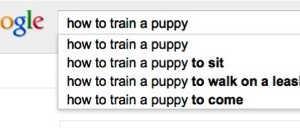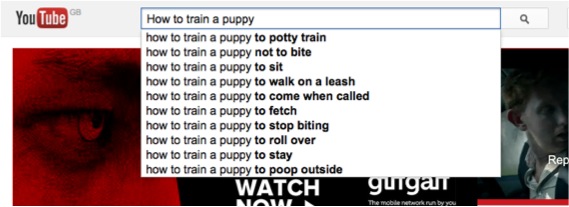Entries Tagged 'Content marketing' ↓
July 10th, 2013 — Content marketing, search engine optimisation, seo
I’m confused.
There are lots of blog posts out there pronouncing that content marketing is killing off SEO.
Who’s writing them?
Are they content marketing companies trying to convince companies that SEO (search engine optimisation) is no longer the way forward because search is social now?
Or, are they narked SEO companies trying to cling on to their huge retainers?
Want to know what I think?
[Doesn’t really matter because I’m going to tell you anyway.]
As far as I’m concerned you can’t have one without the other.
The only reason I can see for SEO companies to throw their toys out of their prams is that they are practitioners of the dark arts. You know the type of company I mean. They are the ones that buy links and use black-hat techniques to trick the search engines into giving their clients good rankings.
But the only way to get quality links is through great content, so don’t the SEO companies and content companies need to work together?
If you’re scratching your head trying to work out where to put your sizeable marketing budget, my best advice is that you need both – you can’t be successful with only one.
A website with sheds load of content is just a dusty online library that may or may not be found. But a website with loads of content and good SEO is a super-charged knowledge bank that will enlighten the world.
Whichever way you look at it if you have content you need SEO and if you have SEO you must have content.
So, no, content marketing isn’t killing off SEO. They should be working together to create a richer, more rewarding search experience.
That’s what I think anyway – what’s your take on this debate?
Sally Ormond is a copywriter and MD at Briar Copywriting Ltd
Find her on Google+
June 10th, 2013 — blogging, blogging for business, Content marketing, Content writer
One of the biggest barriers to content marketing faced by many businesses is ideas generation.
Many decide it’s not even worth considering because they don’t feel able to come up with the constant stream of information a content marketing strategy demands.
But it doesn’t have to be difficult to generate ideas; you just have to look at things a bit differently.
How do you go about coming up with content topics at the moment?
Do you just sit at your desk and stare into space hoping for a blinding flash of inspiration to strike?
That might happen now and then, but you can’t rely on that to generate the constant stream of ideas you need.
That’s where Google, Yahoo, YouTube, Quora, LinkedIn and your customers come in to their own.
Want to know more?
Google – the ideas machine
Google can help you in a couple of ways: through Google Suggest and its related searches results.
With Google Suggest, all you have to do is enter your keyword in the Google search box and then wait for Google Suggest to do its magic.
Below you can see that I entered ‘How to train a puppy’ as my keyword and then Google provided a list of alternative popular searches, providing me with a range of topics that I can write about.

As an added bonus, when you search for that keyword, at the bottom of the search engine results page Google then provides you with a further list of related search terms .

So, from one simple action I now have multiple ideas for content generation.
Yahoo! and Quora
I’ve put these two together as they work in fairly similar ways.
Yahoo! answers and Quora provide content marketers with a plethora of information. They are a great place to start your research. Browsing both sites, using your keywords, will throw up all sorts of ideas based on the questions being asked by users.
After all, if people are asking questions it means they are looking for answers, so they are the topics you want to be writing about.
YouTube
YouTube isn’t just a video viewing website, it’s also a great source for content ideas.
It works in a similar way to Google Suggest in so far as you enter your keyword into the search box and then YouTube will list other related searches.

As you can see I’ve used the same keyword as in the Google example, but here YouTube has come up with a different range of suggestions, so now, one keyword has generated several different content ideas.
LinkedIn groups
Are you a member of any LinkedIn groups? If so, you’ve probably seen the emails that are generated when someone poses a question. Again, these questions are a rich source for your content ideas. Use them to write informative articles that you can then post on LinkedIn, your blog and other article sites etc.
Customers
Last, but by no means least, are your customers.
What better source could there be? Talking to them directly, or monitoring their questions (via email and social media) will unearth a rich source of content ideas, giving them the information they want.
Generating ideas for your content marketing strategy is easy. All you have to do is decide on the subject area you want to cover and then do one or more of the above to generate a whole raft of ideas that you can write about.
Do you use any other methods to generate ideas? If so leave a comment below and share them with us, it would be really interesting to get your take on this subject.
Author:
Sally Ormond is MD and head copywriter at Briar Copywriting Ltd.
March 27th, 2013 — blog, blogging, blogging for business, Content marketing, Content writer
This is a guest post written by Jenn Greenleaf. The views expressed in this post are entirely the author’s own and may not reflect those of Freelance Copywriter’s Blog. If you are interested in submitting a guest post, please get in touch with your ideas
To some, building an audience is second nature. It seems like no matter what these business owners say or do online, they have a genuine following. How does this happen, you wonder? Before getting into that, let’s talk about why they are so
engaged with their audience. The main reason is business. There’s a secret I’m going to let you in on when it comes to building an audience – your business will grow proportionally in size. Here are some tips about how to build an audience.

Keep your blog updated frequently
(source:www.sxc.hu/photo/1165446)
Deliver Content Consistently
Avoid generalizations when writing on your website; instead write as though you were talking to them directly. Develop content that is specific to your niche, especially if you’re selling a specialized product or providing a particular service. Content can be in a variety of forms including blog posts, articles, newsletters, interviews with other experts in the field, product reviews. Visitors to your website want fresh material delivered regularly covering topics relating to their interests.
Offer Freebies
Everyone loves to get something for free, as long as it has perceived value. It’s a perfect way to gain a following for any blog or business. To maximize your benefit, make sure the recipient provides their email address so you can maintain contact. Provide mechanisms for your audience to share these freebies with their own audience on social media. It can be as simple as placing a request to share on the front cover of an e-book or employing a “pay with a tweet” deal, where the person only get the product if they tweet about it. Ebooks are an obvious candidate for free products, but there are many other possibilities including free Kindle books, White Papers, companion guides and webinars. Offer substantial value in the product and avoid using it as an opportunity to sell.

Your audience should never wonder if they are important enough to talk to
(source:www.sxc.hu/photo/948294)
Stay Engaged
Visitors are discouraged when a business owner spends little time posting quality content and rarely engages with readers. The lack of interaction makes the site feel barren and neglected. Provide an immediate and positive response for every blog comment, Facebook post, or tweet. This attention to detail builds respect and garners trust among your audience. As this trust continues to build so does your reputation and ultimately your business, because everyone like to do business with people they can trust.
The Bottom Line
Whether you use social media, search engine marketing or SEO to attract visitors, be as human as possible. Search engines don’t read your blog, people do. There is a fundamental shift occurring in the online world, away from writing for SEO to creating content for human beings. Building your audience is the best way to build a business and insulate yourself from any changes in the major search engines. Great content inspires people to share and gives your business yet more exposure.
Author: Jenn Greenleaf writes about a number of topics including gardening, parenting, and legal matters. You can find out more on reputation.com
February 20th, 2013 — article marketing, article writing, blog, blogging, blogging for business, Content marketing, Content writer
As an online marketer you understand the need for a constant stream of content.
Regardless of whether you’re a B2B or B2C business (i.e. whether you sell to other businesses or direct to consumers), to gain a strong foothold in the search results you must produce lots of high quality content.
The problem is, the time needed to produce that amount of content is rather hard to come by. We are all over worked and finding a few extra hours a week to write can be tough.
Of course, you can lighten the load by encouraging key staff members to produce content for you – many hands and all that – but there are also some other tricks you can use to help generate content and make the most of the stuff that’s already out there.
Recycle your content
We’re not talking about spinning articles for multiple sites, but rather taking a look at the content you have and making the most of it.
If you have a long article, why not break it down into bite-sized chunks – you may get 2 or 3 articles out of one.
Another great tip is to reuse white papers and reports. They will be full of useful information that can easily be broken down into smaller articles and re-written in a more informal style suitable for your blog or website.
Moving away from text, why not re-create the information in a more visual style such as an infographic? That way you can also make use of social sites such as Pinterest. Or you could create videos from the text for your YouTube channel. Everyone likes to take in information differently so by having it in a text, visual and video format there’s something for everyone.
Optimise
This one is more to do with making the most of your content through optimisation.
Everything you produce should be in line with your current SEO (search engine optimisation) strategy utilising one keyword/phrase per article.
It’s also a good idea to make sure that keyword also appears in the URL of your article and in the Alt tags for the images you use.
Standing out
The whole purpose of content marketing is to make it stand out and get it read. If you go for a wishy-washy format that’s pretty boring to look at, no one’s going to take the time to read it.
Make sure you use a strong headline and social sharing icons that indicate how many people have shared your material. Bulleted lists, charts and diagrams all help to add interest and, by keeping your article relatively short, you’ll encourage readers.
Call to action
These are not just for websites and sales materials.
They can be visual cues such as the social share buttons. If you want people to share your stuff or become a fan on Facebook, have markers to show how many people follow you or ‘Like’ you – they won’t want to be left out.
You can use your call to action to get people to sign up to your newsletter, go to a landing page, make a comment, in fact almost anything you can think of.
Get social
If you want people to read your stuff you’ve got to let them know it’s there. Tweet about it, link to it from Facebook, put it on your website and mention it in your newsletters.
Interact with your readers by encouraging comments and responding to them and, as already mentioned, make sure the social share buttons are present to encourage readers to share it with others.
You see, content marketing is not just about generating a constant stream of fresh material; you also need to think about what you already have that can reused in a different format.
By looking at it that way, you should be able to keep up with the demands of your marketing strategy.
January 21st, 2013 — Building a business, Content marketing, copywriter, copywriting tips, website copywriting
Promoting your business online needs a lot of content.
Your website copy, blogs or articles must be relevant, interesting and useful to your readers otherwise they will be no more that just a collection of words.
When you’re a sole trader it’s very easy to fall into the trap of writing about yourself.
Hang on a moment…
Oh, hi Joe (Joe’s a self employed plumber), how’s it going?
What? Yeah, fine. What do you mean trap? Of course I’m gonna write about myself, I am my business and people want to know about me.
Are you sure about that Joe?
Are you taking the p…
Hang on, there’s no need to be like that. Look at it from your customer’s prospective for a moment.
Yeah, they want to know about me, who I am and what I do, obviously.
No, they don’t. They want to know what you can do for them.
Same thing.
No it’s not. Look, the fact that you’ve been in business for 10 years, you drive a blue van and your favourite pizza topping is ham and pineapple is of no interest to your customers. They want to know how quickly you can get to them, and the type of work that you do.
Really?
Yes, really. If they’re searching online for a plumber it’s generally because they have a leak, need a new bathroom installing or something else along those lines. In other words, they have a problem to which they need to find a solution – you. That’s why your web copy, articles and blogs all have to be focused on what you can do for them.
OK, you may have a point.
There’s no maybe about it Joe. If you want your content to be read and you want people to come to your site and think ‘hey, Joe’s the guy for me, he offers the service I need and can come out to me quickly’ then you have to write it for them. If you just fill it with loads of information about you and only you, you’re not giving them what they want.
Joe…hey Joe, where’ve gone?
Just looking at my web copy again…don’t suppose you want to write it for me?
Writing for your readers
Separating yourself from you business and writing about it as though you were a customer is difficult.
You have to place yourself in the shoes of your readers and think about what’s important to them.
These are the basis of the benefits of your product or service – the things that add value to your customers. Keeping them at the heart of everything you write will keep you on track.
One final word – to make sure you don’t deviate, make sure you use ‘you’ instead of ‘we’ on your website, even on your About Us page.
Here are 3 takeways to remember when writing your content:
- Always write for your reader not yourself
- Use a lot of ‘you’
- Write conversationally to boost engagement












